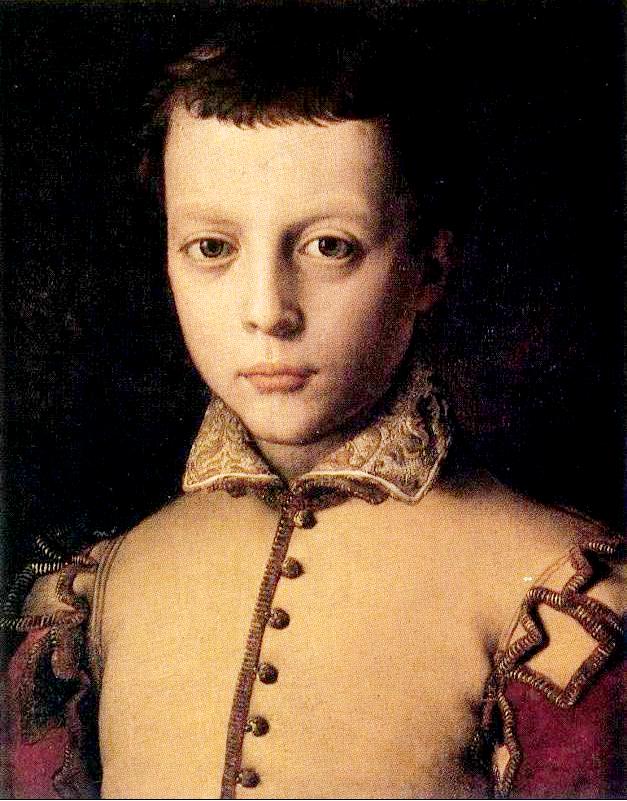
Florence Royalty: Ferdinando I (r1587-1609)

Figure 1.--This portrait is Ferdinando De' Medici (1549-1609) as a boy. He was notvexpected to become the Grand Duke andcas a result was appointed a cardiunakl some time fter the portrait was taken. The artist was Agnolo Bronzino. His proper nme was Agnolo di Cosimo usually known as Bronzino (Il Bronzino). He was was an Italian mannerist painter, born in Florence. His sobriquet, Bronzino, probably refers to his relatively dark skin.
|
|
Fernando I replaced his older brother Francesco as Grand Duke of Tuscany. He probably is as close as one can come to a perfect Renaissance prince, although the small dimensions of Tuscny compared to France and Spain limited his influence. Ferdinando maintained his father's policy and the Grand Duchy prospered although economic changes in Europe were not advantageous to the city. Ferdinando skillfully played the French and Spanish off on each other. Fernando was born (1549). He was the fifth son (third in line at birth) of Cosimo I. His mother as Eleanor of Toledo, the daughter of Pedro Álvarez de Toledo, Marquis of Villafranca, and the Spanish viceroy of the Kingdom of Naples. We know very little about his childhood. Here we see him as a boy (figure 1). Pope Pius IV (one of the Medici popes) made him a Cardinal (1562) Fernando was only 14 years old. It was a sign that he was not expected to being grand duke. Pius IV was best known for preciding over the final session of the Council of Trent. Fernando was never ordained into the priesthood, but worked as a church administrator in Rome. He developed a reputation for a competent administrator. He founded the Villa Medici in Rome and acquired important works of art (including the Medici lions). The Medici were known as patrons of the arts. He brought much of his collection of art back to florence when his briyher died and he became grand duke, he as still a reltively young man (1587). He was very different than his older brother. Contemporaties describe him as approachable and generous. He was a mild ruler. He reestablished a fair justice system and historians described him as being genuinely concerned with the the welfare of his subjects. Fernando managed to reexert the independence of the Duchy that his brother had largely given up. His most important effort was to foster commerce and the Duchy gained substantial wealth through the Medici banks, which were established in the major cities of Europe. This was an important commercial development and a factoir in the invention of capitaism (17th century). He enacted an edict of tolerance for Jews and heretics. Livorno became a haven for the Sephardic Jews that had been driven froim Spain. The Roman Inquisition was not as driven as the Spanish inquisuition.
HBRC

Navigate the Boys' Historical Clothing Web Site royal pages:
[Return to the Main Medici page]
[Return to the Main Florentine page]
[Return to the Main Italian states page]
[Austria]
[Belgium]
[Denmark]
[France]
[Germany]
[German states]
[Italy]
[Luxemburg]
[Monaco]
[Netherlands]
[Norway]
[Romania]
[Russia]
[Spain]
[United Kingdom]
[Return to the Main royal pages]
Created: 7:22 AM 10/7/2018
Last updated: 7:22 AM 10/7/2018



